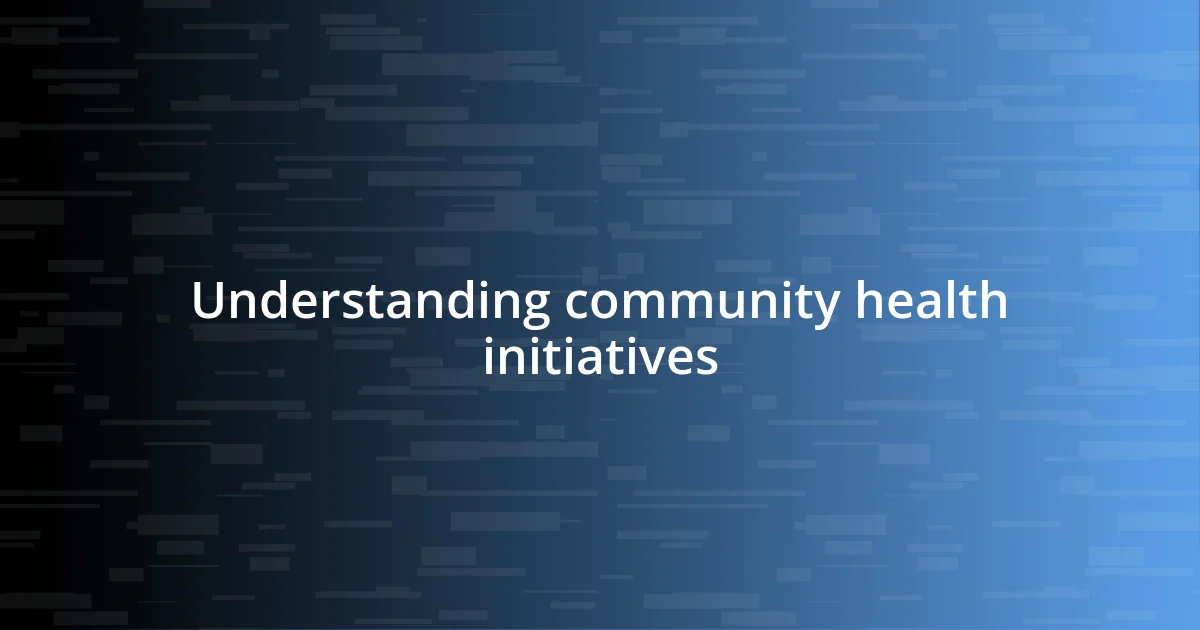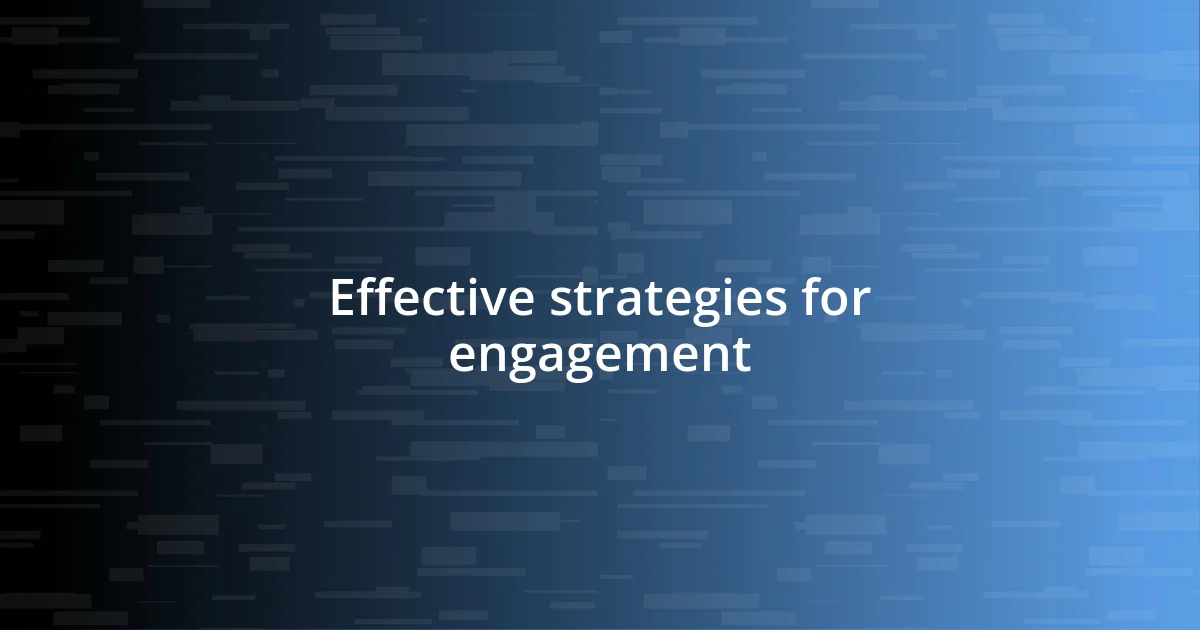Key takeaways:
- Community health initiatives thrive on collaboration among local leaders, healthcare professionals, and residents, fostering a sense of ownership and empowerment.
- Engaging community members through culturally tailored approaches and local events enhances participation and creates a supportive environment for health initiatives.
- Measuring success involves community feedback, tracking outcomes, and celebrating small wins to maintain long-term motivation and involvement in health projects.

Understanding community health initiatives
Community health initiatives are essential because they address the unique health challenges faced by specific populations. I remember attending a local health fair where I saw firsthand how community programs could transform lives. It struck me how some people, who felt isolated due to various health issues, found support and education right in their neighborhood.
What truly stands out for me is the collaborative nature of these initiatives. They often bring together local leaders, healthcare professionals, and residents to identify pressing health concerns. Have you ever thought about how powerful it is when people unite toward a common goal? I’ve witnessed this firsthand in my neighborhood during outreach programs focused on nutrition. It created a sense of community ownership and empowerment that resonated deeply with everyone involved.
Moreover, understanding the cultural context of a community is crucial in designing effective health strategies. For instance, I once participated in a workshop that emphasized culturally tailored approaches to health education. It really opened my eyes to how traditional views on health can significantly influence the success of these initiatives. When community members feel understood and respected, they’re more likely to engage and take action for their health.

Importance of community involvement
Community involvement in health initiatives is pivotal for fostering a deeper connection between residents and their wellbeing. I recall volunteering at a community clean-up event, where we also provided health screenings. The turnout was inspiring—people not only came for the free check-ups but also to engage with their neighbors and share stories. This interaction reinforced how personal participation can lead to a greater collective awareness of health issues affecting our community.
Another aspect that truly resonates with me is the empowerment that comes from community involvement. I remember when my local church organized a health workshop led by residents themselves. The sense of ownership was palpable; everyone contributed ideas, and it morphed into something uniquely relevant. It was eye-opening to see how this grassroots effort cultivated trust and support, as participants felt their voices mattered in shaping health resources tailored to their needs.
Additionally, when communities are involved, there is a shared responsibility which enhances accountability and sustainability. For example, during a local campaign for mental health awareness, I engaged with families who had been impacted by mental health challenges. Their stories emphasized a collective journey toward healing, reminding me how communal support can create lasting change. This demonstrates that when community members take charge, the initiative doesn’t just address health concerns; it fosters a culture of care and collaboration that can reverberate through generations.
| Benefit of Community Involvement | Description |
|---|---|
| Stronger Relationships | Encourages connection among residents, building trust and support systems. |
| Empowerment | Enables individuals to take charge of their health and wellbeing, fostering ownership of health initiatives. |
| Sustainability | Promotes shared responsibility, ensuring health initiatives are maintained and adapted to community needs. |

Effective strategies for engagement
Engaging a community effectively requires a multifaceted approach that resonates with its unique spirit and needs. In my experience, one of the most powerful strategies is leveraging local leaders and influencers. I once attended a town hall meeting led by a respected neighborhood figure who spoke passionately about health resources. The room was filled with energy, as residents felt not just informed, but inspired to take action themselves. This kind of leadership can act as a catalyst for engagement and ownership within the community.
Here are some effective strategies for fostering engagement:
- Utilize Local Media: Stories in local newspapers or broadcasts can raise awareness and spark discussions on health initiatives.
- Create Interactive Workshops: When I helped organize a health cooking class, participants engaged more when they could actively contribute to the meal preparation.
- Host Regular Community Events: Consistent social gatherings help build rapport, allowing residents to form connections and discuss health in a relaxed setting.
- Tap Into Existing Networks: Collaborating with schools or local businesses can extend reach—my local library hosted health talks that drew in a diverse crowd simply by promoting it through their channels.
Engaging the community doesn’t stop at communication; it’s about creating an environment where everyone feels they have a stake in the outcome. I remember a neighborhood fitness challenge that ignited friendly competition among participants. It created a buzz! Suddenly, people were sharing tips, and its success led to a series of engaging events that kept the community invested in their health journey. Integrating fun and excitement can truly transform these initiatives into cherished community moments.

Best practices for implementation
When it comes to implementing community health initiatives effectively, identifying and collaborating with key stakeholders is essential. I remember assisting a neighborhood group that aimed to address obesity among children. We reached out to local schools, health coaches, and even parents to create a cohesive plan. By working together, we harnessed diverse perspectives, which made our approach more comprehensive and welcoming to everyone involved. It’s fascinating how pooling resources can amplify impact.
Regular feedback loops are another best practice I’ve found crucial in ensuring the initiative stays relevant. During a wellness program I participated in, we deployed surveys and held open forums to gather input from participants. It was eye-opening! Their candidness led us to tweak our offerings in real-time, making adjustments that resonated far beyond mere assumptions. Have you ever experienced how just listening can refine an initiative?
Lastly, I believe in celebrating small wins. At a health fair I helped organize, we recognized individuals and groups who made significant contributions to wellness in our community. The laughter and joy during those moments created a positive atmosphere that encouraged more participation in future events. By highlighting achievements, no matter the size, we foster a sense of belonging that propels continued engagement. After all, isn’t it wonderful to feel valued for your contributions?

Measuring success in health initiatives
Measuring success in community health initiatives can sometimes feel elusive, but I’ve discovered some concrete ways to gauge impact. For instance, during a smoking cessation program I supported, we tracked quit rates through follow-up surveys. It was rewarding to see not just the statistics but also hear the personal stories of friends and family celebrating their successes. Have you ever noticed how numbers can come alive when attached to human experiences?
I’ve also found that community feedback plays a pivotal role. In another project focusing on mental health support, we held regular feedback sessions and community meetings. One resident shared how a specific workshop changed their perspective on seeking help. Their story reinforced the importance of listening—not just to what participants want but to how they truly feel about the resources offered. Isn’t it fascinating how one voice can reflect the sentiments of many?
Lastly, I learned that observation is a key metric for success. At a health fair, I watched families interact with various booths, filling out health screenings and chatting with local practitioners. The lively atmosphere indicated that people were not just present—they were actively participating and absorbing information. How often do we simply look at participation numbers without recognizing the energy in the room? Each moment of enthusiasm truly reflects the pulse of a thriving initiative.

Overcoming challenges in health projects
Challenges in health projects often stem from misconceptions or a lack of community trust. I recall working on a mental health awareness campaign where some individuals viewed our efforts with skepticism. We made it a point to engage with these doubters, providing clear information and encouraging open discussions. I found that just taking the time to address fears and misunderstandings can transform initial hesitations into enthusiastic support. Have you ever seen doubt shift to belief through honest dialogue?
Another hurdle can be the limited resources many initiatives face. In a vaccination drive I was involved with, we struggled with inventory shortages and staffing issues. Rather than letting this dampen our spirits, my team and I collaborated with local businesses for supplies and enlisted volunteers to help manage the flow of participants. The feeling of coming together as a community to solve a problem was invigorating! It reinforced my belief that resourcefulness is critical in overcoming obstacles—after all, what challenges can a united community not face?
Lastly, I’ve noted that maintaining motivation can be tough over extended periods. I remember a fitness initiative where participation waned after the initial excitement faded. To rekindle enthusiasm, we hosted fun challenges and themed events that made fitness exciting again. It reminded me of the power of creating experiences that inspire continuous involvement. How do you keep the spark alive in your projects? The joy of rediscovery can be a powerful force in maintaining momentum.












